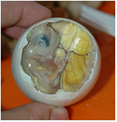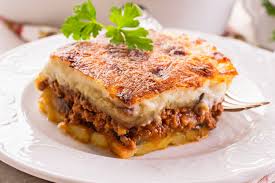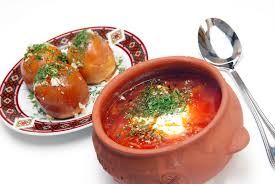- Преподавателю
- Иностранные языки
- Методична розробка уроку на тему: Cuisines of the world
Методична розробка уроку на тему: Cuisines of the world
| Раздел | Иностранные языки |
| Класс | - |
| Тип | Другие методич. материалы |
| Автор | Кваснюк О.М. |
| Дата | 08.03.2015 |
| Формат | docx |
| Изображения | Есть |
The theme of the lesson: National cuisine. Cuisines of the world.
Objectives:
- to activate students'vocabulary;
-
To develop students' reading skills based on a given text;
-
To practice speaking in dialogues and monologues;
-
To deepen students' knowledge of national cuisines of different countries;
-
To practice using the 2nd Conditional
Equipments:English, O. Karpiuk (Student's book); sheets of paper with the text and tasks; cards; multimedia application,computer, CD-player.
Type of the lesson: combined concluding
Procedure
I. Introductory part of the session (lesson time)
T: Hello, my students! Good afternoon, dear guests! I'm glad to see you. Today we are having a final lesson on the topic "National cuisine" .You know, every country has its own eating habits, traditional food and staple products. So we'll speak about different countries and different recipes from all over the world. You will recollect vocabulary on theme, 2nd Conditionals and will have short computer test. So, let's start working
1) Warming up. Pronunciation drills:The teacher shows and hands out students cards (Appendix 1) with the words - transcriptions where some items of reading rules are mentioned and underline. Students read these words, rewrite to their notebook, read one more time and repeat after the teacher .After that listen to the Cd recordings of it and repeat generally and individually.
2) Warming up. Communicative drills. Can you name……
Teacher:Name the foods described below.
-
Can you name a sort of fruit beginning with "A"……
-
Can you name famous red Ukrainian soup beginning with " B"……
-
Can you name an Indian spice beginning with " C"………
-
Can you name the main meal of the day, eaten either at midday beginning with " D"………
-
Can you name a purple vegetable beginning with " E"……….
-
Can you namesomething that people or animals eat beginning with "F"
-
Can you name a fruit that wine is made from beginning with " G"….
-
Can you name a type of meat beginning with "H",……….
-
Can you name a sort of food which is cold and with different flavours beginning with " I"
10) Can you name a sweet substance that you spread on bread made by boiling fruit and sugar together beginning with "J"……..
11) Can you namea fruit witch green inside and brown outside beginning with "K"……..
12) Can you name sugary sweet for kids beginning with " L"………
13)Can you name an Italian cheese used on pizza beginning with " M"….
14)Can you name a dry fruit that consists of a hard shell with a seed inside. Many types of it can be eaten beginning with "N"…….
15) Can you name a white or red vegetable with many layers. It often used
In cooking and have a strong smell that makes some people cry beginning with "O"……
16) Can you name an Italian food made from flour, water and sometimes eggs, formed into different shapes,cooked, and usually served with a souce beginning with "P"…….
17) Can you name a Japanese food beginning with " R"……..
18)Can you name a mixture of meat cut into very small pieces and spices, that is made into a long thin shape beginning with "S"……
19)Can you name a type of orange beginning with " T"…..
20)Can you name a plant or part of a plant that we eat beginning with "V"……..
21)Can you name spicy green root sauce eaten with sushi beginning with "W"……
22)Can you name a food made with fermented milk beginning with "Y"……
ІІ. The main part of the session
3)Speaking. Visual activity. Watching presentation and discussing it in a group (Checking home tasks)
Teacher: Your home task was to prepare a report about national dishes of other countries. Let's listen to the presentations. Now look at the screen(Listening pupils' presentation)
Thank you very much for your reports. Let's continue our work.
4)Development of listening skill. Listening and analyzing:(orally). Each nationality and each country has its national dishes, let's remind the names of the dishes playing a game ''YES OR NO''
Pancakes is a traditional Russian dish -
Salois famous German sausage -
Pudding is a national dish in America.
There is over 600 types of bread in Germany
Ukrainians eat borshch with sour-cream
Indian dishes is made with specific spices.
Main ingredient in Japanese cuisine is RICE
Fish and chips is a popular take-away food in Britain
Okroshka -It is a cold soup in Russian cuisine.
Pizza is a popular Italian dish.
Varenyky are very popular in Ukraine too
Most Ukrainians are vegetarians
5) Reading activity:
1)-pre -reading activity
I Discuss the following questions with a partner.
-
What's the strangest food you have eaten in your life?
-
What strange food do you know?
Top Five Strangest Foods From Around the World

5. Fried - brain sandwiches
Long before the era of Mad-Cow Disease, a sandwich made from fried calves' brain, thinly sliced on white bread was a common item on the menus in St. Louis, Missouri, USA. The sandwich is still available in the Ohio River Valley, where the brains are now heavily battered and served on hamburger buns.

4. Haggis
A traditional Scottish dish, haggis is made with the minced heart, liver and lung of a sheep mixed with onion, spices, oatmeal, salt and stock, and boiled in the sheep's stomach for a few hours. Larousse Gastronomique, a popular encyclopedia of gastronomic delights, claims that haggis has "an excellent nutty texture and delicious savory flavor."
3. Bugs

The practice of eating insects for food is called entomophily and is fairly common in many parts of the world, with the exceptions of Europe and North America. It is not uncommon to find vendors selling fried grasshoppers, crickets, scorpions, spiders and worms on the streets of Bangkok, Thailand. Insects are high in protein and apparently consist of important fatty acids and vitamins.
2. Sannakji

The Korean delicacy sannakji, is something quite different, as the seafood isn't quite dead. Live baby octopus are sliced up and seasoned with sesame oil. The tentacles are still squirming when this dish is served and, if not chewed carefully, the tiny suction cups can stick to the mouth and throat. This is not a dish for the fainthearted.
1.Balut

It is a fertilized duck or chicken egg with a nearly-developed embryo that is boiled and eaten in the shell. It is easily one of the strangest foods in the world. Balut is very common in the Philippines, Cambodia and Vietnam and usually sold by street vendors. It is said balut tastes like egg and duck (or chicken), which is essentially what it is.
2) While - reading activity.(intensive reading)Етап читання тексту.
Pupils read the text one by one.
3) Post reading activity.
II. Answer TRUE of FALSE according to the text.
1. Fried brains caused the mad cow disease. ___
2. The brains are still eaten in USA ___
3. Haggis is made of heart, lung and liver. ___
4. Haggis has a nutritional value. ___
5. Entomophagy refers to eating snakes and worms. ___
6. Sannakji is made of living animals. ___
7. Balut is eaten in Europe. ___
III. Answer the following question.
1. Which of the dishes would you like to try? Why?
2. What's the reading mainly about?
a. How strange food is prepared
b. Places with exotic food
c. Strange food around the world
ІV. Create an exotic recipe; write the ingredients, the way to prepare it and how it is served. (Be creative!)But it will be your home task for the next time.
________________________________________________________
6) Grammar activity.
6.1Revision.( orally)
Teacher: I'm glad you know a lot about traditional dishes of different countries. It's time for us to revise our grammar material. It is the 2- d Conditional. Tell me, please, when do we use the 2-d Conditional? How do we form it? And now let's do some exercises.(Presentation)
6.2. Practice in using.Reading and analyzing activities with grammar accent.(Work in groups).
Activities deals with reading the conditional sentences and analyzing it in pairs.
Teacher: Tell your partners what would you do if…… use 2nd Conditional.
7) Creative activity: "Naming the ingredients .(Work in pairs)
The ingredients of the recipe proposed by the teacher were "accidentally dismissed" and now the task is to put it into the correct order and explain the way of cooking.
8)Writing activity.Reflexing (listening enigma music)
Teacher: Read the following clues and write what food/ dish is describing. Are you tired? Do you want listen to music? Ok let's do it!
9)Video activity. Watching and listening video about food around the world .
Teacher: Eating new foods can surprise you. New foods may seem strange at first. You may be afraid to try them. Foods from other countries may taste bitter. Many foods in our country taste sweet. People in other places put different things in what they cook. You may not have heard of some of the things they use.
a)pre - watching .new lexics ( Teacher's reading, pupils' repeating)
Escargot -равликиcaterpillars - гусениці
jellied eels - заливнівугри to munch -жувати
weird-дивний kidney pie -нирковийпиріг
b) while watching. Pupils watch video and do the quick checking.
c) post watching. Pupils present general ideas of the video in Ukrainian.
ІІІ.The concluding part of the session.
10) Summing up the lesson. Evaluating students' activities and motivating
Teacher: What new words have you learned today? What task was the most interesting?! I want to say that all of you were active and smart, your marks are... because…Thank you! The lesson is over.
11) Home assignments:
Teacher: Students, you home task for the next time will be create an exotic recipe,write the ingredients, they way to prepare it and how it is served. (Be creative!)
Міністерство освіти і науки України
ДНЗ « ПочаївськеВПУ»
Методична розробка уроку
з англійської мови на тему:
"Cuisines of the world"


Підготовила
викладач англійської мови
Кваснюк.О.М
Почаїв 2014


